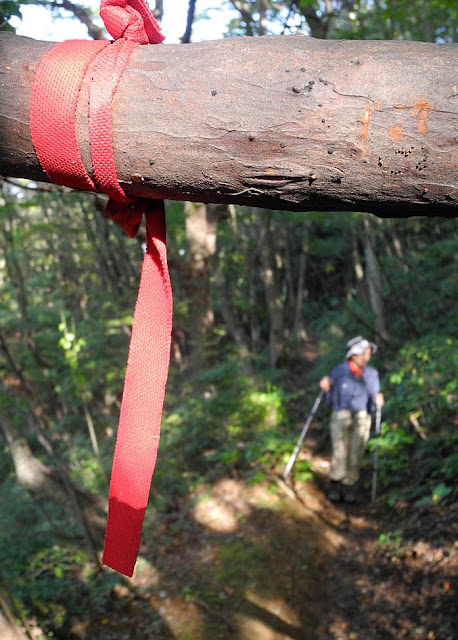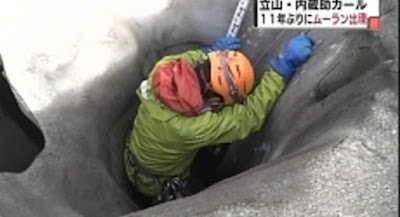October 14: A shrill “Kyaaah!” from up ahead tells me that the Sensei has met a snake. Bears, by contrast, leave her unfazed. By the time I get there, the hapless viper has wriggled off into some hole. It’s unseasonably warm; in our student days, no self-respecting snake would have sunned itself on a mountain path in mid-October.
OK, at 613 metres, this isn’t a very high mountain. We’ve chosen it so that we can get away with a late start. A more
meizanological reason for climbing Ochi-san is that it was the first mountain to be “opened” by Taichō, the monk who later pioneered Hakusan (2,702 metres) in the first year of Yōrō (717).
The start of our own climb is marked by a modest signboard, showing Ochi-san as it was in the heyday of mountain pilgrimages. We zig-zag up through a dense plantation of sugi (cryptomeria). Unlike the one on
Genanpō, this grove is well-tended. We exchange good mornings with a quartet of foresters, who are preparing to shin up the trees with spiked boots and climbing gear in order to trim off the lower branches.
 |
| Sultans of silviculture |
Above the sugi, we start meeting with the labels – each new variety of tree is labelled with its Japanese names and in English too. Unwisely, I start photographing every one, slowing me up so much that I’m far behind the Sensei when she sees the viper. Thus I miss my chance to meet
Gloydius blomhoffii.
 |
| In the shadow zone |
The labels underline Japan’s astonishing biodiversity. I remember a conversation with Ben Jones, the curator of Oxford University’s Harcourt Arboretum. Unlike other temperate regions, he explained, the Japanese islands were never scraped clean by the ice ages. This let a whole herbarium of plants survive that were razed out in more northerly climes. A year or two ago, Ben was in the
Chichibu mountains collecting seeds from one of these old survivors for Kew Gardens. (And, for true plant otaku, here is a
day-to-day account of that trip.)
 |
| Under the greenwood tree |
The path leads onto a straggling ridge. I’m surprised to meet the first beech trees at just over 300 metres – that seems low for this part of Honshū, but perhaps their lower limit has been “downshifted” by the hard Hokuriku winters. Signs marking the “stations” (gome), just as on Mt Fuji, remind us that we’re on a sacred mountain.
 |
| Effacement |
Just above the fifth station, we take our first break at a pavilion that enshrines jizō statues. Some are missing their heads. The Sensei says they lost them during the Meiji government’s campaign to
separate Buddhism and Shinto in the 1870s. I look at a date scratched on one of the headless figures – perhaps the third year of Tempō (1832). The post-Meiji ones seem to be intact.
 |
| Spring time |
After dropping down to a spring that issues from a rockface, we start on a steeper section of ridge. The sunlight filters through a mixed canopy of beech, maple and hornbeam. We pass a Japanese stewartia (natsu-tsubaki) romantically entwined with a Korean whitebeam (azuki-nashi).
A little later, a cherry tree afflicted with witches’ broom disease (tengusūbyō) hints at nature’s darker side.
Now slippery with moss, the path tops a rise and drops into a level glen of fir trees (momi). A torii heralds the main sanctuary.
From the engawa of a building that combines the shrine itself and a mountain hut, an elderly man seems to be waiting for us. “Did anything leap out at you on the way?” he asks – could he have heard the Sensei’s “Kyaah”, I wonder. Then he invites us in for tea.
We make our way past a shed full of jizō figures (these seemed to have kept their heads) to a flight of stone steps leading to the summit sanctuary. As Ochi-san is an eminence in Fukui’s coastal range of hills, the view is all-encompassing.
Westwards, a band of fog elides the boundary between sea and sky while, inland, a single sweep round the skyline takes in all of Hokuriku’s famous mountains, from
Hino to
Arashima,
Kyō-ga-take and
Fujisha.
Beyond them lies the district’s highest Meizan, still without a shred of snow. “It was from here that Taichō first saw Hakusan,” the Sensei says. This seems right. Any meizanophile would see the distant mountains beckoning to them.
We present ourselves again at the door of the priest's house. When we have settled ourselves around the irori, a traditional sunken fire-pit, Otani-san serves out bowls of miso soup, while we share the celebratory red rice presented to us by the Senpai’s wife yesterday evening. They go well together. Dessert is a blackened banana each.
Between April and November, Otani-san lives up here for ten days at a time, going down intermittently to stock up on food. Fortunately – he is over eighty – you can drive all the way up the mountain. The eldest sons of his family have been priests for thirty-one generations; his daughter, a primary school teacher, will carry on the tradition. Before taking over from his own father, he worked for JR and the city administration.
The duties of a priest are various. Once, he had to take down a small shrine that stood in the way of a housing development and haul it all the way up here. Today is quiet but tomorrow a hundred schoolchildren will visit the mountaintop. If they want to read up about the shrine’s foundation, Otani-san has a short print-out ready for them.
Ascents of Ochi-san book-end the story of Monk Taichō’s life. A plausible date for his birth is the month of June in Hakuhō 11 (682), in the village of Asōzu, now part of Fukui City. Curiously, one of the Sensei's relatives was born there too.
The dates are deduced from a biography, the
Taichō wajō denki that was published some centuries later. As a child, Taichō is said to have fashioned Buddhist images out of mud and, at the age of fourteen, he climbed Ochi-san for the first time, where he venerated the Eleven-Headed Kannon.
In 716, when Taichō was thirty-four, the goddess of Hakusan appeared to him in a dream, and the following year he climbed the mountain. According to Nihon Hyakumeizan, this was the first ascent of a high mountain in Japan for religious ends. On the summit, the goddess appeared to him again, this time in the guise of the Eleven-Headed Kannon.
In 722, he journeyed to Nara, the capital, and cured the Empress Genshō of an illness. In 736, he visited the capital again, and received from Monk Genbō a copy of an Eleven-Headed Kannon sutra. The following year, the ninth of Tempyō, he performed a rite of repentance to ward off an outbreak of smallpox that threatened the capital. For this he was raised to the high monastic rank of “wajō”.
Returning to his home province, he climbed Ochi-san again in the second year of Tempyō-Hōji (758) and retired to a cave to meditate. He died in 767 at the age of eighty-six.
It's time to go. We bow to the priest at his door, receive his blessing, and start down. One tends to forget that, even if autumn days are now unseasonably warm, that doesn’t make them any longer than they used to be. Shadows are lengthening by the time we reach the Sensei’s van.






















































